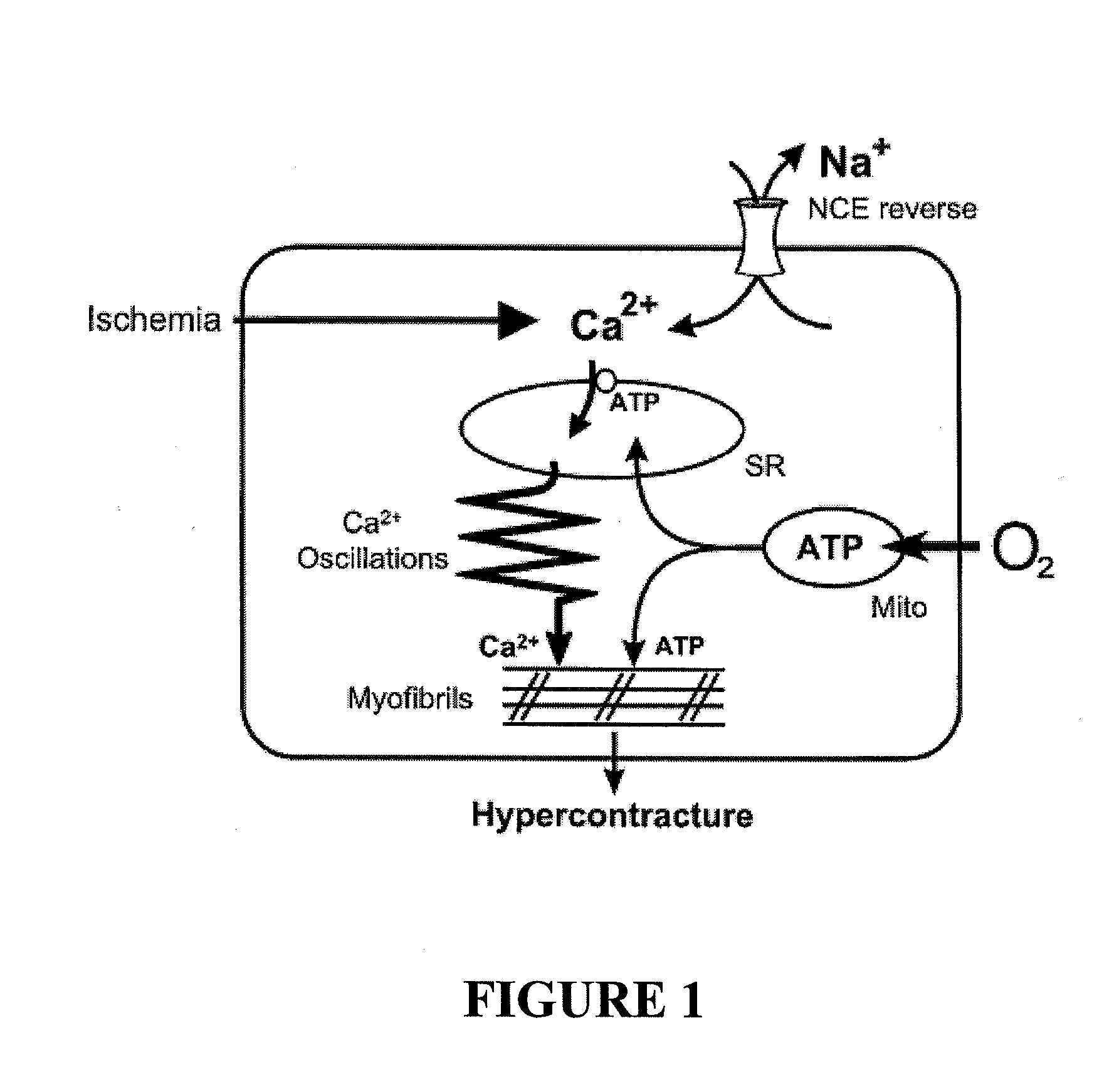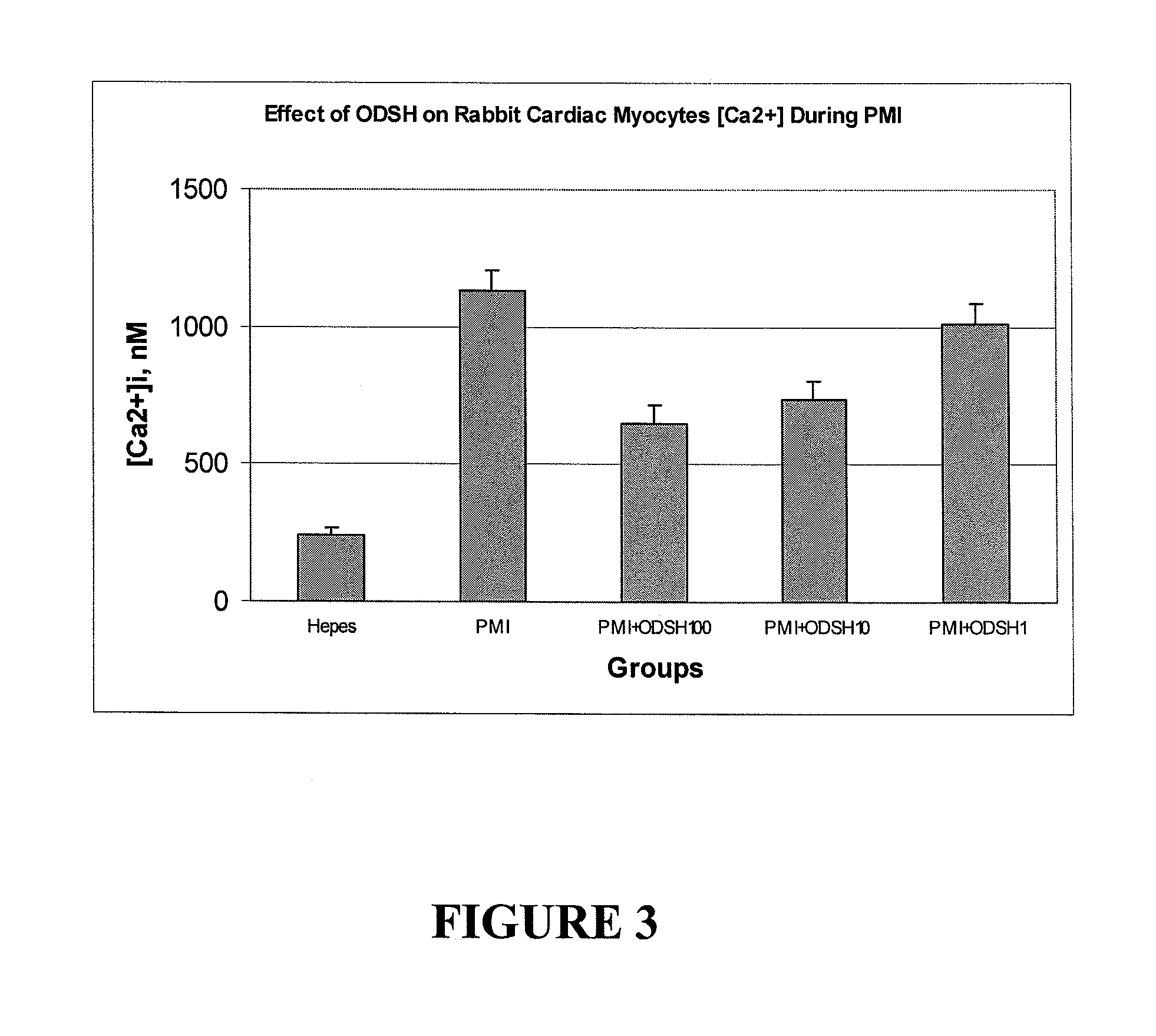Methods for controlling intracellular calcium levels associated with an ischemic event
- Summary
- Abstract
- Description
- Claims
- Application Information
AI Technical Summary
Benefits of technology
Problems solved by technology
Method used
Image
Examples
example 1
Inhibition of Ischemia-Induced Intracellular Calcium Overload by 2-O, 3-O Desulfated Heparin
[0120]This example demonstrates how 2-O, 3-O desulfated heparin prevents dangerous accumulation of intracellular calcium in cardiac myocytes by blocking ischemia-induced increases in the late sodium current. Consequently, it prevents intracellular sodium overload and subsequent reverse mode operation of the sodium-calcium exchanger. The effect of 2-O, 3-O desulfated heparin on accumulation of intracellular Ca++ during ischemia was studied in an adult rabbit ventricular myocyte model previously reported (Boston D R, et al. J Pharmacol Exp Ther 285:716-723, 1998; Li F, et al. J Mol Cell Cardiol 33:2145-2155, 2001). Isolated cardiomyocytes have been validated as reliable models of ischemia (Diaz, R J, Wilson G J. Cardiovasc Res 70:286-296, 2006).
[0121]To produce the model, hearts are removed from albino rabbits (2-3 kg) anesthetized with sodium pentobarbital (65 mg / kg IV). The heart was immediat...
example 2
Reduction in Ischemic Cardiac Necrosis by 2-O, 3-O Desulfated Heparin in a Porcine Closed Chest Model
[0133]To study the utility of 2-O, 3-O desulfated heparin (ODSH) in reducing ischemic tissue injury from injurious Ca++ overload, a closed chest porcine model of cardiac ischemia was used. The study was designed to determine if previous findings indicating the protective effect of ODSH in reducing myocardial infarction reperfusion injury in open chest dogs were reproducible in an animal model of ischemia / reperfusion injury more relevant to humans. The results indicate that 2-O, 3-O desulfated heparin, when given just before relief of ischemia, reduces myocardial necrosis and the size of myocardial infarction in a pig model of this disease. The protective effects observed with pharmacological preconditioning with ODSH have been attributed to the anti-inflammatory activity of heparins, since ODSH impairs neutrophil rolling through inhibition of P- and L-selectins, and also significantl...
example 3
[0147]2-O Desulfated Heparin does not Activate Platelets in the Presence of Heparin-Induced Thrombocytopenia Antibody
[0148]To be used safely in the treatment of prevention or treatment of ischemic-induced Ca++ overload, a heparin derivative would have to be free of the dangerous side effect of inducing heparin-induced thrombocytopenia type II, referred to as HIT. It was determined whether 2-O desulfated heparin was free from HIT activation properties usually manifested by unfractionated heparin (UFH). The potential of 2-O desulfated heparin (ODSH) to interact with HIT antibody and active platelets was studied using donor platelets and serum from three different patients clinically diagnosed with HIT, by manifesting thrombocytopenia related to heparin exposure, correction of thrombocytopenia with removal of heparin, and a positive platelet activation test, with or without thrombosis. Two techniques were employed to measure platelet activation in response to heparin or 2-O desulfated ...
PUM
| Property | Measurement | Unit |
|---|---|---|
| Fraction | aaaaa | aaaaa |
| Mass | aaaaa | aaaaa |
| Mass | aaaaa | aaaaa |
Abstract
Description
Claims
Application Information
 Login to View More
Login to View More - R&D
- Intellectual Property
- Life Sciences
- Materials
- Tech Scout
- Unparalleled Data Quality
- Higher Quality Content
- 60% Fewer Hallucinations
Browse by: Latest US Patents, China's latest patents, Technical Efficacy Thesaurus, Application Domain, Technology Topic, Popular Technical Reports.
© 2025 PatSnap. All rights reserved.Legal|Privacy policy|Modern Slavery Act Transparency Statement|Sitemap|About US| Contact US: help@patsnap.com



